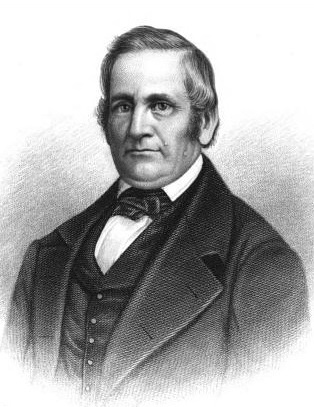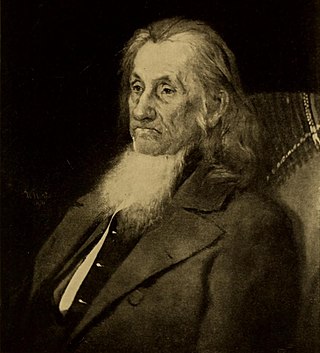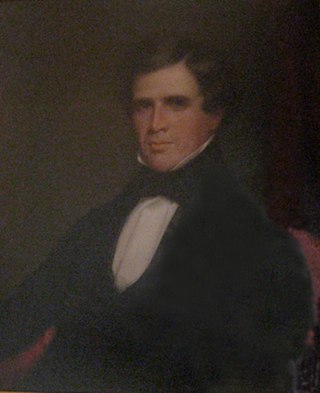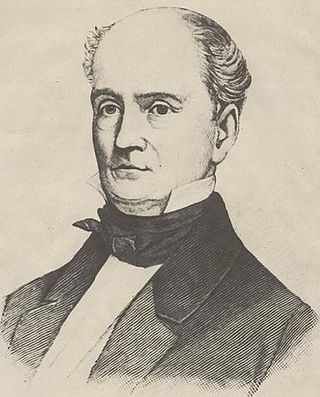The Anti-Masonic Party was the earliest third party in the United States. Formally a single-issue party, it strongly opposed Freemasonry in the United States. It was active from the late 1820s, especially in the Northeast, and later attempted to become a major party by expanding its platform to take positions on other issues. It declined quickly after 1832 as most members joined the new Whig Party; it disappeared after 1838.

Silas Hemenway Jennison was an American Anti-Masonic and Whig politician who served as Vermont's 11th lieutenant governor and 14th governor of Vermont – the first born in the state.

John Staniford Robinson was an American lawyer and politician. He is most notable for his service as the 22nd governor of Vermont, from 1853 to 1854.
The Vermont Republican Party is the affiliate of the Republican Party in Vermont and has been active since its foundation in the 1860s. The party is the second largest in the state behind the Vermont Democratic Party, but ahead of the Vermont Progressive Party. The party historically dominated Vermont politics until the mid-20th century, but was replaced by the Vermont Democratic Party. The party currently has very weak federal electoral power in the state, controlling none of Vermont's federal elected offices. The only statewide office that the party currently controls is the governorship, held by Phil Scott.

The 1834 New York gubernatorial election was held from November 3 to 5, 1834 to elect the Governor and Lieutenant Governor of New York. This was the first fall election in which the Whig Party participated.

The 1845 United States Senate special election in New York was held on January 18, 1845 by the New York State Legislature to elect two U.S. Senators to represent the State of New York in the United States Senate. The regular 1845 United States Senate election in New York was held on February 4, 1845, to elect a U.S. Senator to represent the State of New York in the United States Senate.

The 1852–53 United States Senate elections were held on various dates in various states, coinciding with the 1852 presidential election. As these U.S. Senate elections were prior to the ratification of the Seventeenth Amendment in 1913, senators were chosen by state legislatures. Senators were elected over a wide range of time throughout 1852 and 1853, and a seat may have been filled months late or remained vacant due to legislative deadlock. In these elections, terms were up for the senators in Class 2.

David M. Camp was a Vermont attorney and politician who served as the 12th lieutenant governor of Vermont from 1836 to 1841 under Governor Silas H. Jennison.

Allen Wardner was a Vermont banker, businessman and politician who served as State Treasurer. He was also the father-in-law of Attorney General, Secretary of State and United States Senator William M. Evarts.

The 1853 Vermont gubernatorial election took place on September 6. The same three candidates who ran for governor of Vermont in 1852 ran again in 1853: Whig and incumbent Erastus Fairbanks, Democratic candidate John S. Robinson, and Lawrence Brainerd, the nominee of the Free Soil Party. The results showed that Fairbanks had received 43.9 percent of the vote, with Robinson receiving 38.5 percent, and Brainerd 17.6 percent.

The 1834 Vermont gubernatorial election took place in September and October, and resulted in the reelection of William A. Palmer to a one-year term as governor.

The 1835 Vermont gubernatorial election was held on September 1, 1835.

The 1836 Vermont gubernatorial election was held on September 6, 1836.

The 1837 Vermont gubernatorial election was held on September 5, 1837.

The 1838 Vermont gubernatorial election was held on September 4, 1838.

The 1840 Vermont gubernatorial election was held on September 1, 1840. Incumbent Whig Governor Silas H. Jennison defeated Democratic nominee Paul Dillingham with 59.58% of the vote.

The 1841 Vermont gubernatorial election was held on September 7, 1841.

The 1842 Vermont gubernatorial election was held on September 6, 1842.

The 1843 Vermont gubernatorial election was held on September 5, 1843.

The 1844 Vermont gubernatorial election was held on September 3, 1844.



















